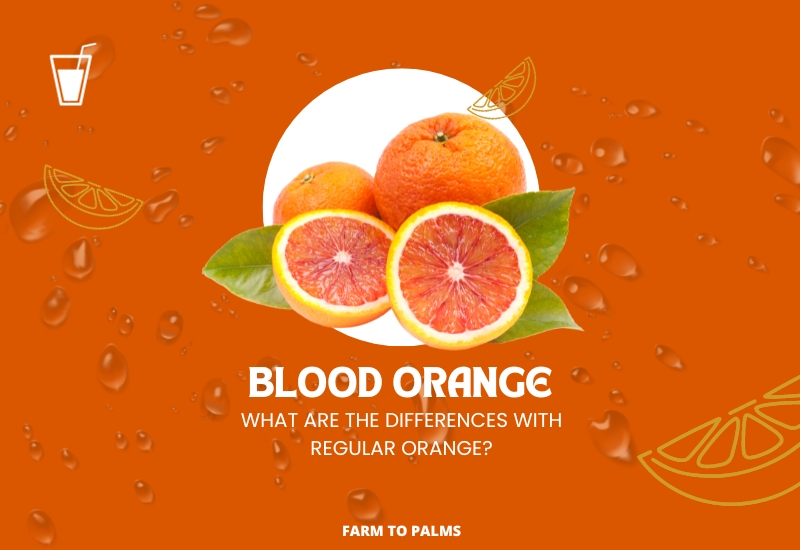There are several varieties of blood oranges, each with different sensory qualities and undeniable health benefits. The blood orange stands out from the typical orange due to its high anthocyanin content, giving its flesh that characteristic blood-red color.
Among citrus fruits, the orange is the most consumed fruit in France (12 kg per year per household). Its richness in vitamin C and antioxidants makes it a recommended fruit. However, despite being equally nutrient-rich, the blood orange still needs to be discovered.
Characteristics of Blood Orange
- Rich in vitamin C;
- Rich in antioxidant anthocyanins;
- Source of fiber;
- Prevention of cardiovascular diseases;
- Boosts immunity.
What Is a Blood Orange?
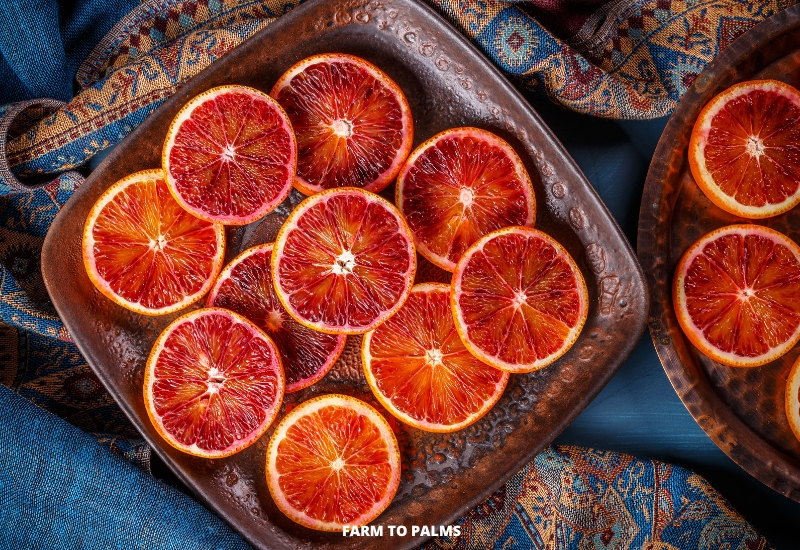
A blood orange is a type of citrus fruit resembling a conventional orange in terms of external appearance. However, its distinguishing feature lies in its profoundly red-colored fruit and juice. This vibrant hue is attributed to anthocyanin, a pigment that develops as the citrus fruits ripen amid warm days and cool nights.
The formation of anthocyanin begins along the periphery of the peel and subsequently progresses along the edges of the fruit segments before permeating into the flesh. Consequently, blood oranges may exhibit streaks or lines of red rather than a completely uniform blood-like coloration. The extent of pigmentation can be influenced by factors such as the harvesting season, specific variety, and prevailing climatic conditions.
Notably, blood oranges have characteristics that set them apart from other oranges. They generally offer easy peeling, fewer seeds, and a sweeter flavor profile. Due to their seasonal availability from December to April, blood oranges may be more complex to procure and command a higher price than more common varieties like navel oranges.
What Does It Taste Like?
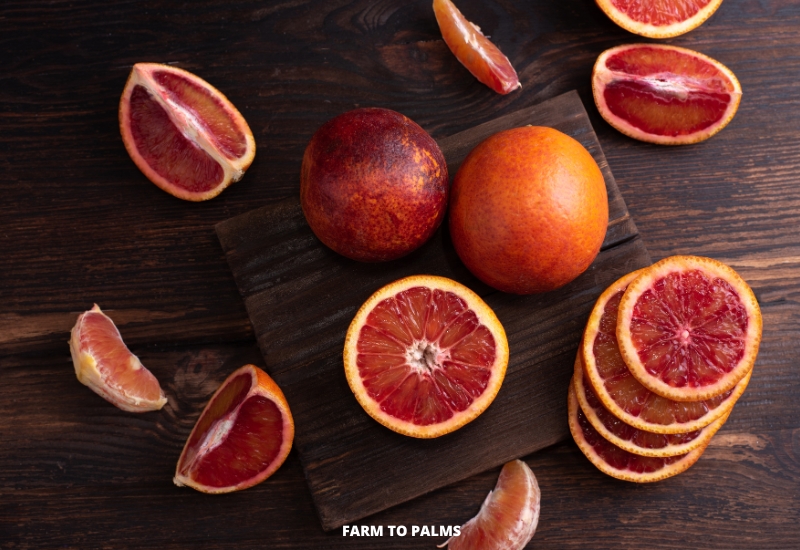
Blood oranges exhibit variations in taste depending on the specific variety being consumed. Compared to conventional oranges, they possess a reduced tanginess and offer a more pronounced floral or tart flavor profile. Diverse blood orange varieties may impart distinctive taste notes reminiscent of orange juice infused with raspberry, cranberry, or fruit punch nuances. While the mouthfeel of blood oranges mirrors that of regular oranges, their segmented structure typically contains fewer seeds.
Why do blood oranges taste different?
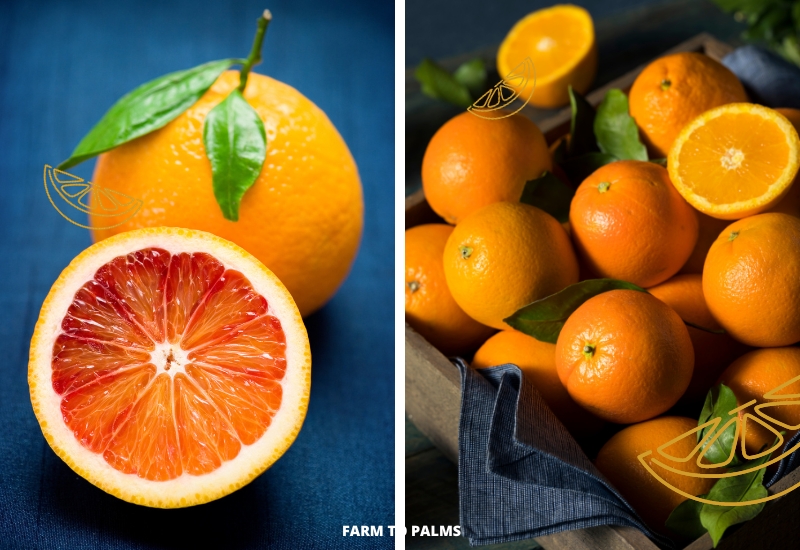
Blood oranges taste different from regular oranges because of their unique flavor profile. The distinct taste of blood oranges can be attributed to their high anthocyanin content, which is responsible for the deep red color of their flesh. Anthocyanins are natural pigments found in certain fruits and vegetables, and they contribute to the fruity and slightly tangy flavor of blood oranges.
Blood oranges have a sweeter and less acidic taste than regular oranges. This sweetness is due to the higher sugar content in blood oranges, which gives them a rich and flavorful taste. The combination of sweetness, tanginess, and fruity notes makes blood oranges stand out in terms of flavor.
It’s important to note that the taste of blood oranges can vary depending on factors such as the variety of blood oranges, growing conditions, and ripeness. Some blood oranges may have a more robust citrus flavor, while others may be more subtle. The unique taste of blood oranges adds to their appeal and makes them a popular choice for citrus lovers.
Nutritional and caloric values of blood orange.
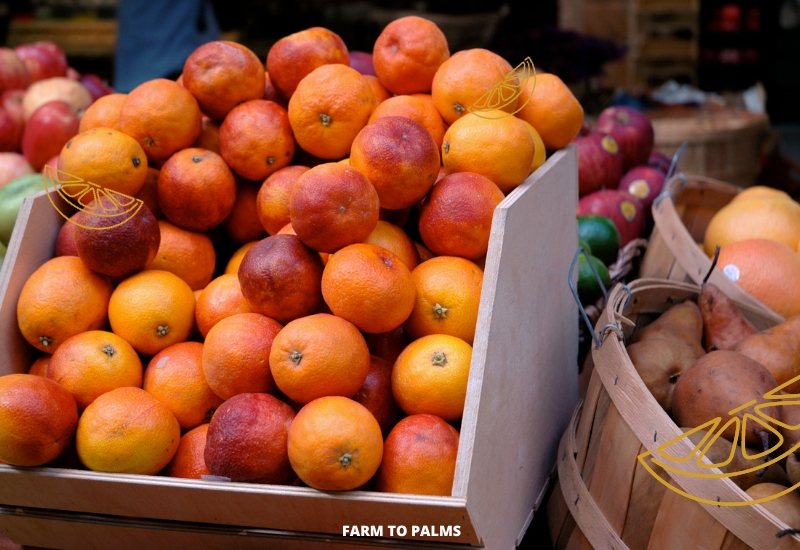
Like all citrus fruits, the blood orange is rich in vitamin C and fiber. Compared to its cousin, the orange, its advantage is its richness in polyphenols and anthocyanins. It is low in calories and fits perfectly into a varied and balanced diet (the recommendations for fruit consumption from the PNNS in January 2019 are three servings per day).
For 100g of blood orange:
| Nutrients | Average content |
|---|---|
| Calories | 45.5 |
| Water (in g) | 87.3 |
| Proteins (in g) | 0.75 |
| Carbohydrates (in g) | 8.03 |
| Fats (in g) | less than 0.5 |
| Dietary fiber (in g) | 2.70 |
| Calcium (in mg) | 66 |
| Vitamin C (in mg) | 47.5 |
The benefits of blood orange

Rich in nutrients, blood oranges differ from common oranges in their content of anthocyanins and fiber.
Protective anthocyanins
Consuming foods rich in antioxidants is necessary to limit oxidative stress caused by free radicals.
The anthocyanins present in blood oranges belong to the large family of antioxidants. The consumption of antioxidants may reduce the prevalence of chronic degenerative diseases such as:
- Cardiovascular diseases
- Certain cancers
- Diabetes
- Alzheimer’s disease
- Age-related cognitive decline
(Rui Hai Lui, Cornell University, NY, USA, 2004, Department of Nutrition)
Vitamin C boosts the immune system.
Vitamin C stimulates the immune system and enhances the absorption of non-heme iron by 35%.
Consuming blood oranges is beneficial for vegetarian and vegan individuals, as it provides a significant source of vitamin C.
Blood oranges can help overcome minor winter infections with their vitamin C content.
Additionally, vitamin C has antioxidant properties and reduces fatigue.
Fibers are beneficial for digestion.
Blood oranges contain fiber; some varieties have even more fiber than common oranges.
Some varieties of blood oranges have seeds that can be consumed. These, along with the fibers found in the fruit’s flesh, are an exciting source of fiber, especially for people with sluggish intestinal transit. Fibers accelerate digestion and help alleviate constipation.
Fibers also help reduce the intestinal absorption of glucose, thereby avoiding significant fluctuations in blood sugar levels. They also reduce cholesterol absorption. Lastly, fibers have a satiating effect that helps minimize snacking.
The word from the nutritionist
Vitamin C oxidizes quickly; therefore, once squeezed, consume your blood orange juice without delay if you want to benefit from this vitamin’s benefits.
How do you choose blood oranges?
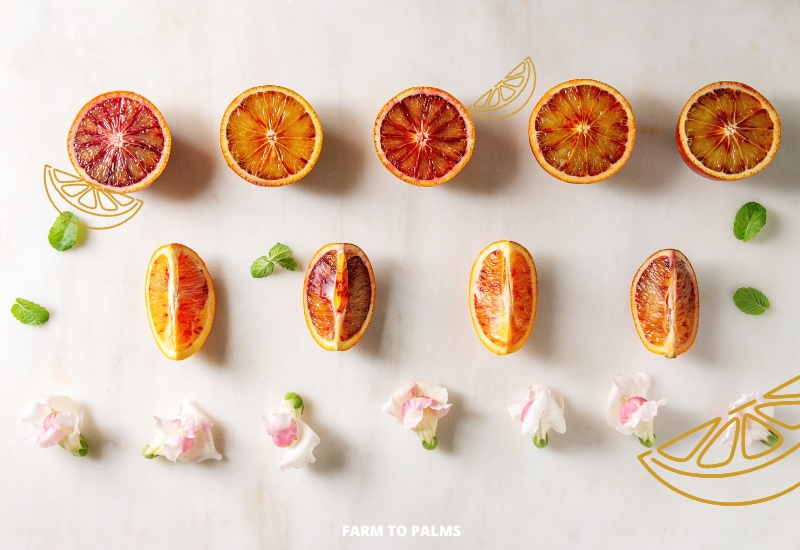
A blood orange weighs approximately 150g, with orange skin pigmented with red. There are three varieties of blood oranges:
- Moro
- Sanguinello
- Tarocco
Identification of blood orange:
- Family: Rutaceae
- Origin: Sicily/Spain
- Season: December to April, depending on the varieties
- Color: Bright orange skin speckled with violet, blood-red flesh
- Flavor: Tart
The “Moro” Variety
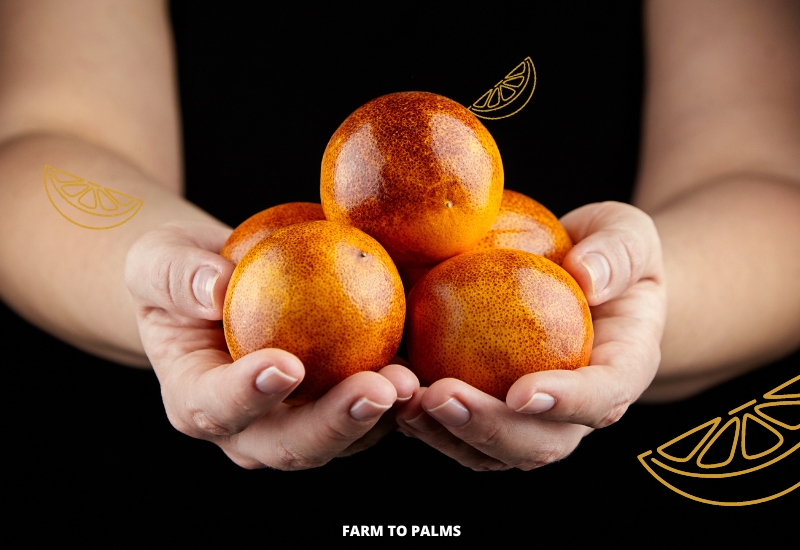
This variety is the most colorful, with red flesh and few seeds. It is slightly more bitter than the other two varieties. The skin is thick and can be found in stores from December to March.
The “Sanguinello” or “Sanguinelli” variety

This variety originates from Spain and has reddish skin and seedless, juicy, sweet flesh. It is ideal for breakfast fruit juice. It is available from February to April.
The “Tarocco” Variety
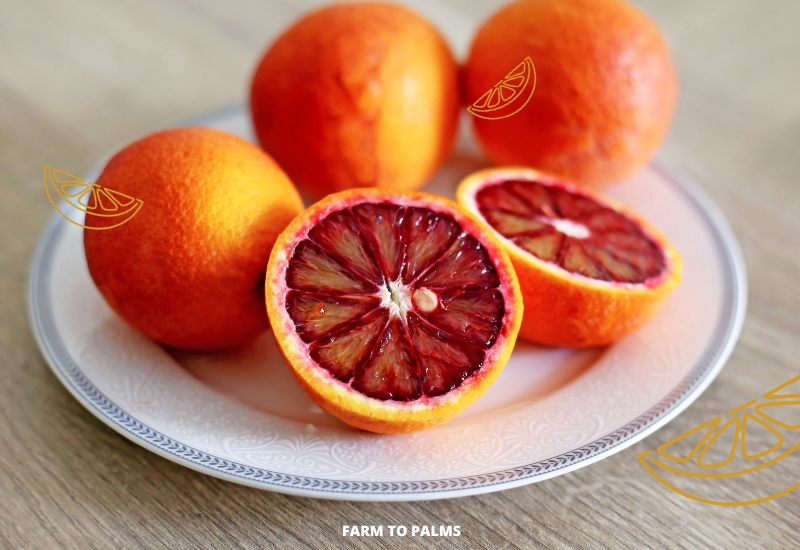
Produced in Sicily, this variety is the sweetest and juiciest of all. It reaches maturity from December to February. Its skin is bright orange, sprinkled with violet.
Proper storage
You can store your blood oranges at room temperature for up to one week. Alternatively, you can freeze the segments or freshly squeeze the juice to enjoy its vitamins throughout the year.
How to prepare blood orange?
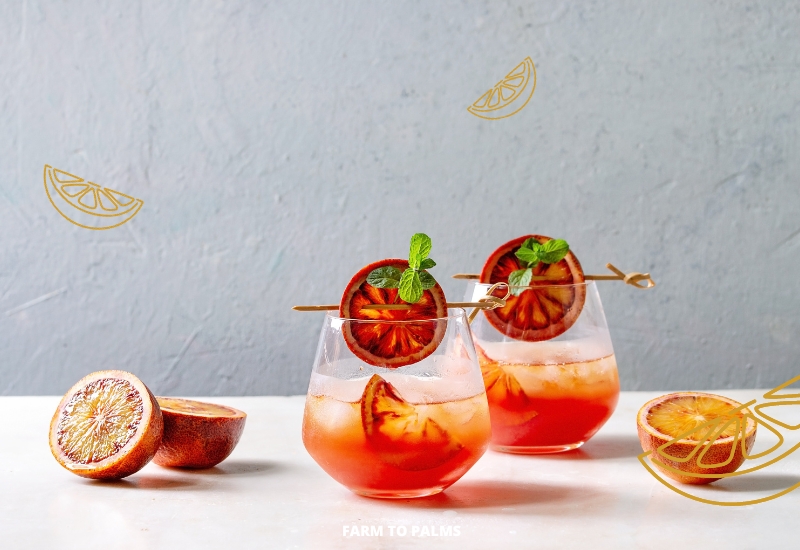
To enjoy all the health benefits of blood oranges, it is best to consume them fresh and raw, but they can be incorporated into savory and sweet dishes.
For vitamin C, go for the juice.
When squeezed, blood oranges are a true vitamin C “shot.” The juice can be consumed for breakfast or made a tangy vinaigrette. However, fruit juices have a higher glycemic index than whole fruit, so it is good to alternate between orange juice and entire blood oranges.
In salads with supremes
If you enjoy vegetarian salads rich in iron, try combining lentils with blood orange supremes. The vitamin C in blood oranges will enhance iron absorption from lentils and help prevent iron-deficiency anemia.
Paired with chocolate
For the more indulgent eaters, you can make “orangettes” by coating blood orange peels with dark chocolate, which is richer in cocoa and, therefore, higher in iron and magnesium. Although the orange, in this case, is candied and has a lower vitamin C content, it will still aid in iron absorption from the cocoa. Beyond the sweet pleasure, this combination also has nutritional benefits.
With meat
Blood oranges pair perfectly with meats; top chefs often offer duck oranges.
Other preparations
Other preparations that will delight your taste buds include traditional orange marmalade, sorbet, or the famous orange wine, for which you must choose the most bitter variety of blood orange.
Are blood oranges expensive?
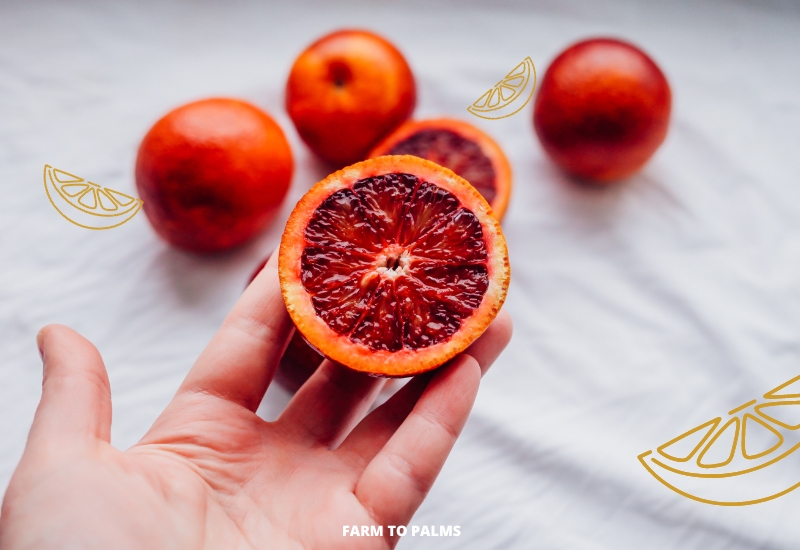
The pricing of blood oranges can vary depending on various factors such as the region, season, and availability. Generally, blood oranges tend to be slightly more expensive compared to regular oranges due to their unique flavor and limited availability. However, the price can differ based on location and the specific market conditions. It is recommended to check with local grocery stores or farmers’ markets to get the most accurate and up-to-date pricing information for blood oranges in your area.
How To Store Blood Oranges
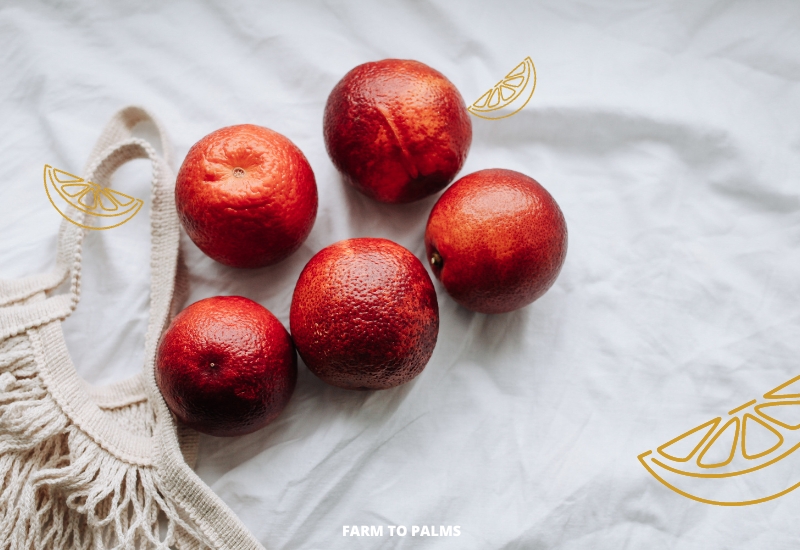
To preserve whole blood oranges, one may leave them at room temperature for a maximum of four days or refrigerate them for up to two weeks. On the other hand, orange segments and halves can be stored in a hermetically sealed container in the refrigerator for several days.
When extracting the zest from these oranges (a recommended practice), any surplus zest should be frozen for future use. To achieve this, evenly spread the zest on a tray, freeze it, and transfer it to an airtight container. This method allows the zest to maintain its quality for four to six months.
It is advisable to utilize fresh orange juice immediately for optimal flavor and nutritional value. If necessary, the juice can be stored in a securely sealed container for a few days. Alternatively, a viable option is to freeze the juice by pouring it into ice cube trays and subsequently transferring the frozen cubes into an airtight container. These ice cubes can also serve as an aesthetically pleasing addition to various cocktails.
Before zesting the oranges, it is recommended to eliminate any wax residue by gently scrubbing the fruit with a vegetable brush or any brush with stiff bristles while rinsing it under warm water. It is essential to only zest the colored part of the peel, as the white pith tends to taste bitter.
Blood oranges exhibit remarkable versatility as a fruit. They can be effectively employed in recipes that traditionally call for regular oranges. However, their true magnificence manifests in beverage applications. From margaritas and tequila sunrises to gin or vodka-based concoctions, the vibrant red hue of blood oranges adds a captivating touch to any libation they grace.
Contraindications and allergies to blood oranges
Contraindication
Some varieties of blood oranges are more acidic than others, so consumption should be moderate in individuals suffering from GERD, esophagitis, gastritis, and gastric ulcers.
History and Anecdotes
A little bit of history
Two thousand two hundred years ago, the orange was mentioned for the first time in a treatise of Ayurvedic medicine. Initially cultivated in China, it was introduced to Sicily and Spain by the Persians and Arabs in the 11th century. It later spread to Southern France. Different varieties, including the blood orange, emerged after that.
Good to know
The level of anthocyanins varies depending on the day/night temperature difference, with higher content resulting from a more significant gradient.
Where to Buy Blood Oranges
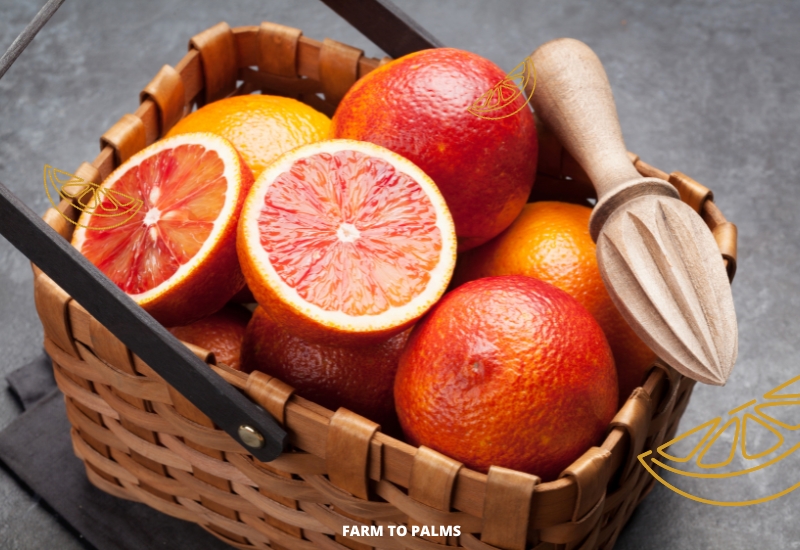
Blood oranges thrive in temperate climates with a combination of hot and cooler weather, which encourages the development of their distinct color. The Mediterranean region is believed to be their origin, and specific California and Florida areas provide suitable conditions for their growth. Consequently, blood oranges are typically harvested during the winter season. In the United States, these oranges are commonly available for purchase from December through April, although the duration may vary depending on the weather conditions of a particular year.
To acquire blood oranges, one can visit farmers’ markets in regions where they are cultivated or seek out specialty stores. Typically, these oranges are sold individually rather than pre-bagged or in bulk, as they are considered less common than navel oranges.
When selecting blood oranges, choosing fruits that feel weighty for their size is advisable, as this indicates their juiciness. While some blood oranges may have orange-colored exteriors, the true appeal lies in their deep red flesh. Therefore, if given the option, opting for blood oranges with darker and redder skins is preferable, as they are more likely to possess a flesh that aligns with their name.
In suitable climates (USDA Zones 9-10), individuals can cultivate blood orange trees at home. Certain trees can thrive in larger containers and be brought indoors during cooler temperatures. Optimal growth conditions include total sun exposure, well-moistened soil, and a warm outdoor climate with temperatures ranging from 60 to 85 degrees Fahrenheit. Alternatively, maintaining a constant average indoor temperature of 65 degrees Fahrenheit can also support the growth of these trees.
At Farm to Palms supermarket, you can easily find blood oranges. We constantly import a variety of fresh and delicious fruits to ensure that our customers are served consistently and with the highest quality.

